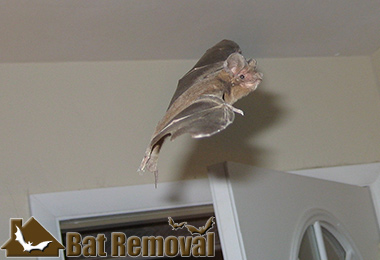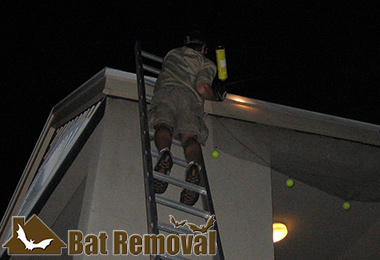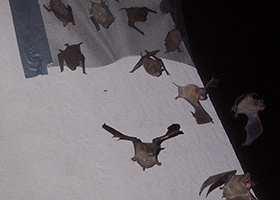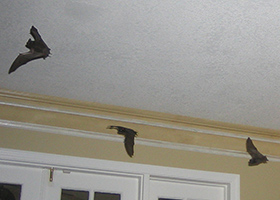Charleston Bat Removal
Welcome to Charleston Bat Removal! We are South Carolina bat removal specialists. It is important to know that bats are protected by South Carolina law, and are beneficial animals to have in the environment. We do not kill any bats during our bat removal process. Never hire a pest control company or anyone who says they are a Charleston bat exterminator. For correct and effective bat removal, you want a company that specializes in humane bat colony extraction. Our process is not only the only legal method in South Carolina, but it is the most effective. We have a 100% success rate in our bat control process. We perform our industry-best 32-point inspection of your house or building, and seal shut all bat entry holes down to 1/4 inch as part of the removal process, during which we remove the colony via special one-way exclusion devices specific to your architecture. Once all bats are safely out, we permanenetly bat-proof the structure. We also provide guano (bat droppings) removal and decon. Click on our Charleston Bat Control Prices page to find out more about our prices for bat control work. We work 24/7/365, and would love to talk to you about your bat problem. Call us any time at 843-261-5078 to discuss it, discuss our pricing, and if you wish, set up an appointment at your convenience, often same-day.

Charleston Building and Attic Inspections

No-kill South Carolina Bat Extraction

Guano Cleanouts - Serving all of South Carolina
Call 24/7 to discuss your bat problem.
Same-day or next-day appointments.
32-point inspection of your property.
Written estimates for bat removal project.
Fully state licensed and insured.
Residential and commercial service
100% no-kill Charleston bat extraction
Complete bat-proofing of your building
Compliance with all South Carolina, federal laws
Guano removal and attic decontamination
Our Service Range - 843-261-5078



The Bats Are Not Rodents
Bats are known for their rounded ears and fuzzy nose. These features are common among rodent creatures. Therefore, some people will refer to them as flying rodent or winged rats. However, according to the study, they do not belong in the family of the rodents. Bats are classified under the Chiroptera order while the rodent belong in Rodentia order. Once the bats and the rodents are grouped in a single order, they will make at least 50 percent of the mammals' population.
Why Bats Are Not Considered Rodents
Originally, it is believed that the bats are related to the primate creatures such as apes, monkeys, and even humans. The structure of the bat's heart is composed of 4 chambers. They have backbone, mammary gland, hair, and an intricate function of the brain. With at least 1,200 bat species, they make up the 25 percent of the population of mammals.
The Bats Flying Ability
Compared to most mammals, bats have fully mastered their flying ability. Therefore, some people will associate them with birds. However, they are also not related to birds. The way that their flight ability has evolved is completely different to birds. The Chiroptera order where they belong literally translate to 'hand wings.' When you observe the wings and membrane of the bats, you will realize that this absolutely makes sense. Their wings will appear like fingers that are spread apart.
The way that the bats navigate while they are in air is completely different to birds. You probably think that the bats are blind and will heavily rely on their echolocation ability. This is a common myth since the bats have an incredible sense of sight. They will be emitting their high-pitch noise and their sight when foraging and evading solid surfaces.
Lack of Fossil Evidence
Since the bats are fragile creatures, it is difficult to find a complete fossil of the ancestors of the bats. This makes it difficult to determine the relatives of the bats. They have tiny and delicate bones that are easily destroyed. As aforementioned, bats are believed to be related to humans. However, according to the most recent studies and the genome analysis of the bats, they are now considered a part of this superorder that include whales and pangolins.
Short History of the Bats
Looking at the history of the bats will allow the experts to determine the association of the bats. Unfortunately, even the history of the bats is complex. The scientists have collected teeth that allegedly belong to the early bats. In addition, they have also pieced together bat skeleton that can be traced back to 50 million years ago. Sadly, the appearance is almost like the modern bats. This makes it more difficult to trace the early history of the bats.
While they are not considered rodents such as the rats and mice, the damage that they can cause and disease that they may carry can rival the threats of the rodents. They can also invade our house and cause structural damages.

